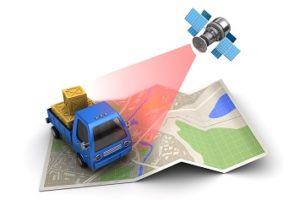Companies with large fleets, like package delivery companies, police departments, and public transportation providers, have long used GPS-based fleet tracking systems to closely monitor their vehicles. Fleet tracking offers companies a more efficient way to track and dispatch drivers. In addition, they can save employers time and money and improve environmental performance by reducing fuel consumption.

Madmaxer / iStock / Getty Images Plus / Getty Images
Better Efficiency, Better Performance
When drivers spend excessive time sitting in traffic, idling; when they habitually accelerate aggressively; or when vehicles are not maintained in a timely fashion, fuel economy suffers. A GPS fleet tracking system helps employers to plan travel routes and dispatch drivers more efficiently, reducing idling time; to identify drivers whose driving habits waste fuel; and to schedule vehicle maintenance for optimal performance.
I Spy …
Employees are sometimes resistant to fleet tracking systems. They may feel that management is just looking to spy on them. It’s true that a fleet tracking system will help you to identify drivers who may be using company vehicles for nonwork purposes, or who are not operating their vehicles safely, or who are just taking too long to get their jobs done. But that’s not the purpose of a fleet tracking system; it’s only a side effect, and one that will benefit the business and any honest, hardworking employees.
Tell employees exactly what information your fleet tracking system will provide—and how it will improve their ability to do their jobs:
- Vehicle location. Knowing where each vehicle (and each driver) is at all times enables dispatchers to identify the closest driver to any job. This benefits the employer by providing timely service to customers and minimizing the amount of transit time between jobs—especially important in businesses that take calls and dispatch drivers throughout the day, like taxi services, tow trucks, and home heating and air service providers. It benefits employees by minimizing the time they spend going from one job to the next, enabling them to spend more time working and less time traveling.
- Routes taken. How workers get from point A to point B can be significant. A fleet tracking system will track the route taken and how long it took, enabling employers to identify the best routes over time, as well as viable alternate routes for working around road closures or heavy traffic. Again, this will improve fuel efficiency and minimize travel-related downtime for operators.
- Time spent at each stop. This tool can be especially beneficial for drivers with “regular routes.” Employers that estimate the amount of time each stop will take when creating routes and schedules will have much more accurate information to work from, which will improve work planning and customer service. Drivers will benefit from not feeling rushed at longer stops and will be better able to get home on time.
- Speed the vehicle was traveling. OK, yes, this will give you some solid information on who might be driving a little carelessly—but it will also, and more importantly, give you information on when the vehicle wasn’t traveling, because it was stuck in traffic, held up by lights, or otherwise delayed. Again, this information can help you with route planning and fuel-efficiency optimization.
If that’s not enough to persuade your drivers that GPS fleet tracking is not just a disciplinary tool for rooting out problem employees, point out that it could also be the opposite—a system for identifying and rewarding good drivers.
Tomorrow we’ll look at another benefit of fleet tracking systems that may help you sell it to your workers—improved driver safety.
